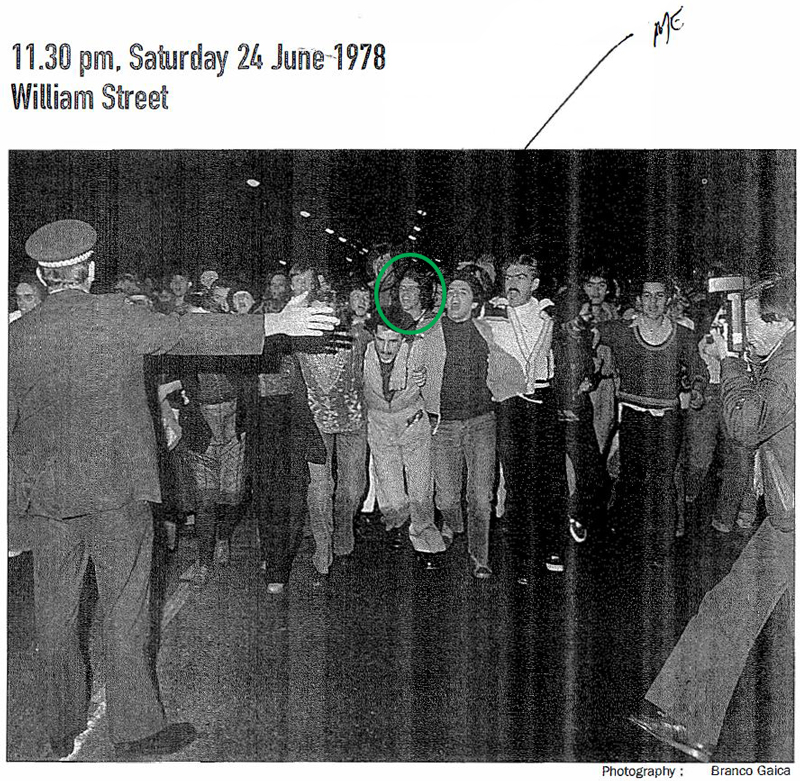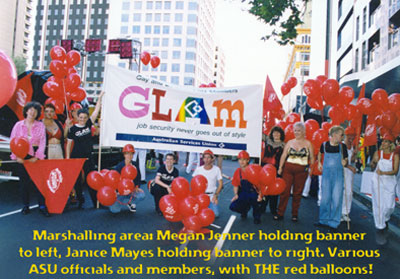How a once-off street party became an iconic annual event
Today, everyone acknowledges the iconic status of the annual Sydney Gay & Lesbian Mardi Gras as both a key Australian cultural and political event, even its opponents admit this. Bitterly. However, few know the origins of the event. Even fewer know Neil’s story of the event, a member of the ASU community who was there and has agreed to share his personal anecdotes. Together, this nutshell history of the origin of the Mardi Gras, sprinkled with Neil’s recollections, is a broader story of how ordinary people can bring about big changes through participation and tenacity.
 In June 1978, it was heady times for political activists in Australia. Less than three years after the Whitlam dismissal, progressives were still energised by Gough’s term which had shown what could be achieved in a short period. After 23 stultifying years of conservative, mostly Liberal rule, the genie of progress was well and truly out of the bottle. They were also ‘maintaining the rage’!
In June 1978, it was heady times for political activists in Australia. Less than three years after the Whitlam dismissal, progressives were still energised by Gough’s term which had shown what could be achieved in a short period. After 23 stultifying years of conservative, mostly Liberal rule, the genie of progress was well and truly out of the bottle. They were also ‘maintaining the rage’!
Neil was 19, a law clerk living in the inner Sydney suburb of Paddington with an appetite for fun and an interest in changing the world.
He and his ALP mates, a few of whom were gay, often hung out at the same pubs as people in the burgeoning Sydney gay scene, but aside from that, there was probably not a great deal of intermixing between the groups socially. Politically, however, there was a lot more overlap.
In the mid-70s, members of the ALP began campaigning for the repeal of the buggery laws which were still in force. Mind you, there were no laws against lesbian sex, an anomaly famously put down to Queen Victoria refusing to believe that women would engage in such a thing, so she would not give such laws royal assent. Unfortunately, that little gem is an urban myth which reputedly began in New Zealand in 1977 (see our footnote for a few fascinating details).
In any case, Neil in his role as a law clerk in a suburban firm knew from his day to day work that repealing the buggery laws was not just an idealistic correction of an archaic moral view unfairly enshrined in secular law, but that the repeal would have the practical effect of freeing hundreds, if not thousands, of gay men from legal prosecution for their private and consensual adult relationships.
At the same time that elements of the ALP were turning their mind to the repeal of the provisions of the Crimes Act containing the buggery laws, there were numerous political enclaves active in 1978 where the cause of gay and lesbian equality was much more front of mind. It was there that the idea that became the annual Gay and Lesbian Mardi Gras was born.
The idea for the Mardi Gras arose from a confluence of sources. A couple of members of the SWP (Socialist Workers’ Party), one of the key activist groups at the time with gay and lesbian credentials, received a letter from San Francisco’s Gay Freedom Day Committee seeking support for California’s annual Gay Pride Day celebrations to counter threats from the New Right in the US. The SWP agreed to support the American Gay Pride Day but also to simultaneously protest British conservative icon Mary Whitehouse’s upcoming visit to Australia and raise awareness of the gay and lesbian cause.
At around this time, and arising from a group discussion following the screening of “The Word Is Out”, an American documentary showing scenes of “campy” parades in the US, the idea for an “apolitical street party” at night was raised by activist Ron Austin. Further discussions led to activist Margaret McMann calling Austin’s idea a “mardi gras” and it was included as part of the broader protest actions organised for Saturday 24 June 1978 by the organising collective, which also formulated four key demands:
“It wanted the police to stop harassing gay men and lesbians. And it wanted the government to repeal NSW’s anti-homosexual laws and the Summary Offences Act, to stop workplace discrimination and to protects lesbians’ and gay men’s rights.” Harris, Witte, et al
Arrangements for the protest actions were all above board, with march permits duly obtained, a truck with PA system hired to lead the parade and extensive leafletting and word-of-mouth promotions to encourage participation.
On the night of 24 June, Neil and his mates knew about the planned parade and had been priming for it at one of the pubs nearby.
“We had a few schooners in the Royal in Paddington before we set off and of course we had a few travellers with us to keep us happy as we went,” he recalled.
Famously, the festive marchers called out to others to get “out of the bars and into the streets!” as they made their way up Oxford Street to Hyde Park. Neil recalls this chant being modified for other establishments along the way, the most memorable for him being “out of the hairdressers and into the streets!”
Photos from the early part of this very first Mardi Gras Parade show the sense of fun and celebration with many participants costumed up for the occasion. To music from the leading truck PA system (Neil particularly recalls Tom Robinson Band hits ‘Glad to Be Gay’ and ‘2-4-6-8 Motorway’ being played), many danced up the golden mile, as that stretch of Oxford Street was known.
The smiles, dancing and high jinx started to disappear when the Parade reached Hyde Park and the police decided to roughly cut short announcements coming from the PA, including the reading of solidarity telegrams. With a fight breaking out and matters escalating with the police confiscating the truck and the PA, the now angry crowd spontaneously decided to extend the march to the El Alamein fountain in Kings Cross.
The photo we have of Neil on the night is from this phase of the Parade. People have linked arms to strengthen the line and are yelling for the repeal of buggery provisions.
When the paddy wagons appeared and police started throwing people into them, Neil and his mates Christine and John were among the first to be arrested by virtue of being towards the front.
The police bundled them into the back of the paddy wagon without much ceremony and Neil suffered a minor injury to his ankle when the police closed the wagon door on it.
Almost immediately, a number of lesbians had begun rocking the paddy wagon, demanding the release of their girlfriend: “They were banging on the sides shouting ‘you can’t take our girlfriend’ and suddenly the door opened and in the resultant confusion John and I ‘finished up outside the paddy wagon’! But alas, not poor Christine, who got to make a lot of new friends in the women's lockup that night.”
Neil, in his legal capacity, arranged for Christine’s bail and release the next day and arranged for a Barrister to represent her on the charges from the Parade, all of which were eventually dropped by the police.
The following Saturday, outraged activists retraced the Mardi Gras Parade route, looking for police to incite. Neil also participated in this event, “It didn't take much to get us into the streets. We had a big demo the following week and marched all over Sydney trying to provoke the cops but they wouldn't come out!”
Presumably, following the controversial brutality of the week before, police were keeping a low profile, so the demonstrators, undeterred, marched to the Darlinghurst Police Station where another confrontation ensued and more arrests followed.
By August 1978 the events arising from the Parade in June, including the police ‘beatings and humiliation’, and the public outing and vilification by the Sydney Fairfax media of those who marched (the Sydney Morning Herald this year issued an apology for their reporting of the Parade and aftermath) a meeting of the National Homosexual Conference resolved to commemorate the Mardi Gras riots by holding a Gay and Lesbian Mardi Gras Parade each year. Take that!
 The participants of the first Mardi Gras Parade on 24 June 1978 are now known as 78ers to acknowledge their foundational act. So our storyteller Neil is a bona fide 78er! He’s proud of his involvement (it’s his favourite ‘war story’ we’re told by a credible source) and not at all bitter about his near arrest and injury by the police, “All straight taking one for the cause.”
The participants of the first Mardi Gras Parade on 24 June 1978 are now known as 78ers to acknowledge their foundational act. So our storyteller Neil is a bona fide 78er! He’s proud of his involvement (it’s his favourite ‘war story’ we’re told by a credible source) and not at all bitter about his near arrest and injury by the police, “All straight taking one for the cause.”
Today, Neil Henderson is the Secretary of the ASU’s Queensland Services & Northern Administrative Branch (aka The Services Union). Neil continues to support and pursue policies for LGBTIQ equality both within our Union and in the broader political arena.
We thank Neil for regaling us with his story and allowing us to share this great nugget of Australian activist history with the bigger audience that it deserves. The take away message? When you’re fighting injustice from on high, persistence is key, and a bit of music and dancing helps, too!
Researched & written by Brigid Marasco
ASU National Communications Officer
with the kind assistance of Neil Henderson,
ASU-Qld Services & Northern Admin Branch Secretary
Footnotes
The myth of Queen Victoria’s refusal to grant royal assent to laws prohibiting lesbian sex apparently began as recently as 1977 across the ditch in New Zealand. It was a fictional story created to explain why another march, this time specifically for lesbian equality, was by the statue of Queen Victoria in Wellington.
The Scotsman, ‘Background: Myth of Victoria and ban on homosexuality’, 30 January 2011
http://www.scotsman.com/news/background-myth-of-victoria-and-ban-on-homosexuality-1-1499082
If you have a story to tell about fighting for rights for the LGBTIQ community, please contact us via webkeeper@asu.asn.au
Sources
![]() Gavin Harris, John Witte, et al, ‘It was a riot! Sydney’s First Gay & Lesbian Mardi Gras’, for 78ers Festival Events Group, 1998
Gavin Harris, John Witte, et al, ‘It was a riot! Sydney’s First Gay & Lesbian Mardi Gras’, for 78ers Festival Events Group, 1998
The Guardian, ‘State MPs to apologise for mistreatment of first Sydney Mardi Gras marchers’, by Paul Karp, 21 February 2016
https://www.theguardian.com/australia-news/2016/feb/21/state-mps-to-apologise-for-mistreatment-of-first-sydney-mardi-gras-marchers
Sydney Morning Herald, ‘The Sydney Morning Herald apologises to Mardi Gras founders the 78ers’, by Daisy Dumas, 24 February 2016
http://www.smh.com.au/nsw/the-sydney-morning-herald-apologises-to-mardi-gras-founders-the-78ers-20160224-gn26jm.html
The Guardian, ‘Sydney Morning Herald apologises to original 1978 Mardi Gras protesters, by Paul Karp, 24 February 2016
https://www.theguardian.com/world/2016/feb/24/sydney-morning-herald-apologises-to-original-1978-mardi-gras-protesters
The Guardian, ‘How the beatings and humiliations of the 1978 Sydney Mardi Gras made reform inescapable’, by David Marr, 24 February 2016
https://www.theguardian.com/world/2016/feb/24/how-the-beatings-and-humiliations-of-the-1978-sydney-mardi-gras-made-reform-inescapable
Wikipedia, “Tom Robinson” of the Tom Robinson Band: https://en.wikipedia.org/wiki/Tom_Robinson

